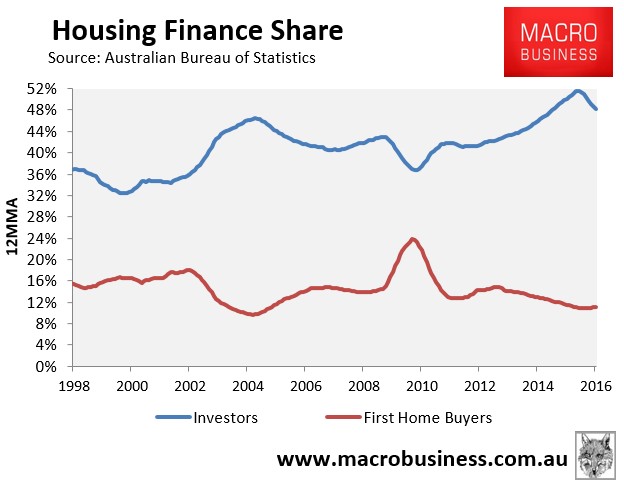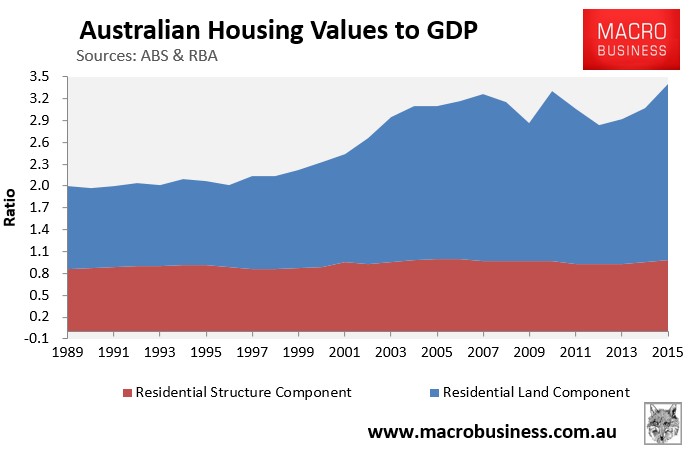With zero mention of housing affordability in the Federal Budget, Prime Minister Malcolm Turnbull has found his scapegoat: Australia’s building unions.
That’s right, in the above election ad, Turnbull suggests that cracking down on union corruption is a way of improving housing affordability:
“We’re paying up to 30 per cent more for hospitals, schools and roads. Even housing affordability is affected because of the high cost of building apartments”…
So Turnbull won’t address the fact that hyper-investor speculation has directly crowded-out first home buyers (note the inverse correlation below):

Or that most of the cost appreciation has been in the land, not the structure component:


No, he has instead pinned the blame for Australia’s atrocious housing affordability on the unions. Convenient, hey?
When you think about it, there are two broad approaches at Turnbull’s disposal to make homes more affordable for younger Australians:
- Remove artificial (speculative) demand from the market; and/or
- Introduce measures that improve the supply of affordable land/housing.
Unfortunately on the demand side, Turnbull has opposed Labor’s sensible reforms to Australia’s negative gearing and capital gains tax system, despite describing them as “tax shelters” and “tax avoidance” in 2005.
So this leaves the supply-side.
If Turnbull was serious about housing affordability he would offer incentive payments to the states to free-up land supply, relax planning, and build housing-related infrastructure. It is the federal government, after all, that has decided to run a high immigration program, so the least it can do is provide the states – the ones primarily responsible for service delivery and infrastructure – with the means to cope with this growth.
Given the massive vertical fiscal imbalances present in the federal system, it is not surprising that the states have attempted to prevent growth of the urban footprint in a bid to save on infrastructure costs. Accordingly, the best way to overcome the states’ reluctance is to ‘show them the money’ and offer them incentive payments in return for genuine supply-side reforms.
Most importantly, the “First-User-Pays-All Model” used to fund housing-related infrastructure must go. As explained by regular MB reader, Pfh007, the First-User-Pays-All Model works as follows:
- Developers are forced to provide the long lasting housing infrastructure, that largely benefits the entire community;
- Developers then dump almost the entire cost on the first user of the land (usually a first home buyer), who then tries to pay for it with a jumbo-sized mortgage, much of which our banks borrow offshore;
- Local and state councils are then motivated to try to load as much expense on the home buyer as possible, and often also whack on a nice assortment of fat levies and contributions as well;
- The end result is a system that encourages gold plating and over charging when bringing land to market and forces the most vulnerable and less financially secure people pay the cost with hundreds of billions of foreign debt that requires a taxpayer guarantee.
The First-User-Pays-All Model is a key reason why fringe lot values have experienced hyper-inflation over the past 15 years. It is also why first home buyers are being gouged circa $600,000 to live in a basic 3 bedroom house 50 kms from Sydney and why there is almost no-demand for expensive new housing like this unless interest rates stay close to zero.
Again, as explained by Pfh007 (here and here), instead of the First User Pays All model for financing development costs, a much smarter solution is for the federal government to pay the servicing and development costs of bringing the land to market and then recover part or all of the cost from rates or taxes on the land over the next 20-30 years .
The commonwealth can do it directly via a Commonwealth Land Tax (which existed between 1910 until 1953) or have the state government collect it as rates and remit the required amount back to the federal government (or bond holder).
Again, the reason why the federal government should lead the way and fund housing-related infrastructure is because it controls population growth via its control of migration, and because the federal government can borrow at lower cost than the home buyer or the state governments.
If Malcolm Turnbull remains reluctant to fund such vital infrastructure, the federal government could instead set up a Municipal Utility bond model (explained here and here), like the one operating in Houston Texas, and then let the growing self-managed superannuation fund (SMSF) sector do the funding. The returns will be secure if the rates/taxes are a first charge on the property, and the SMSF industry is begging for simple secure long term investments that generate a steady return. In any event, the model certainly beats the current one whereby SMSFs are having a punt with retirement savings on the housing bubble.
None of these solutions are rocket science. But it will take genuine leadership from Malcolm Turnbull to achieve genuine supply-side reform, not lazy lip service blaming the unions.

